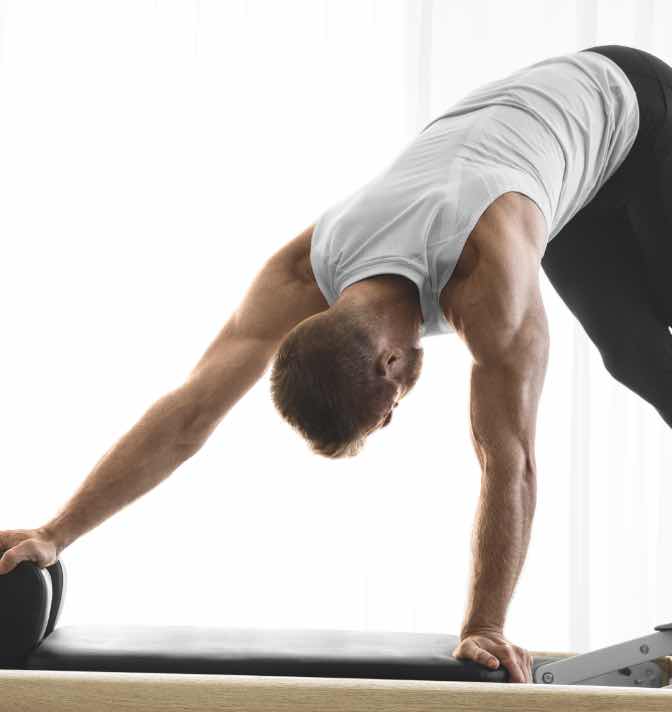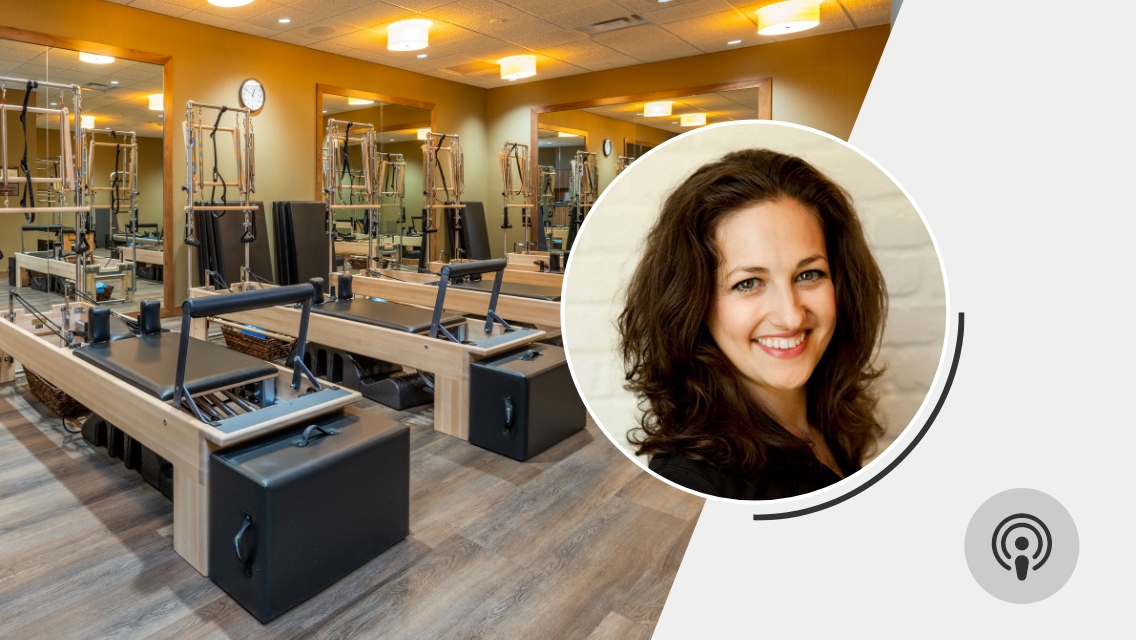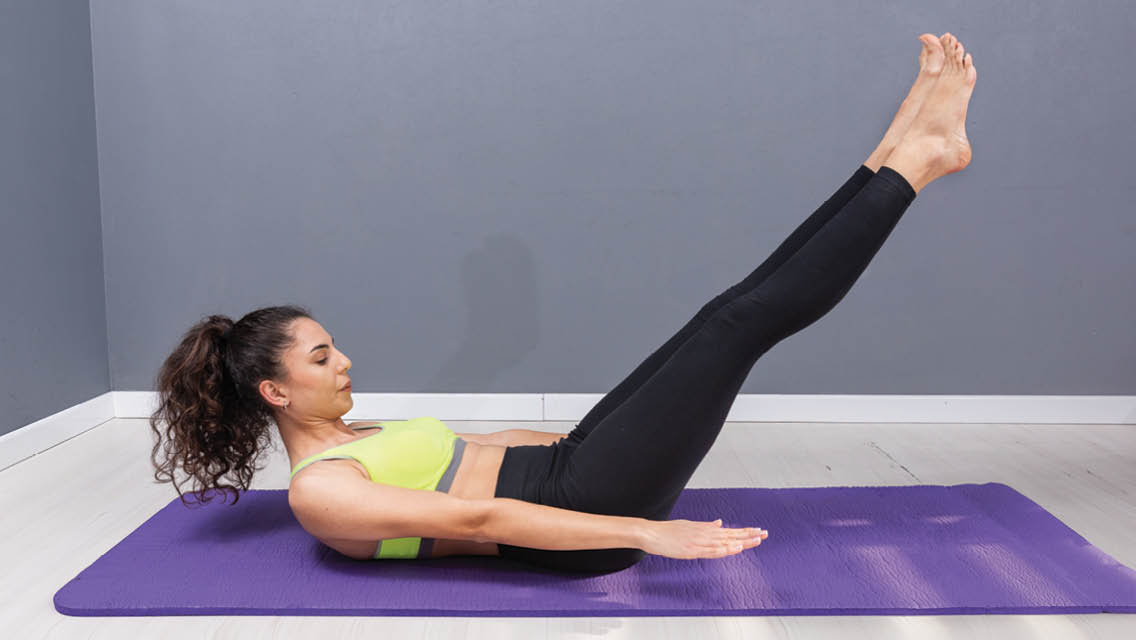When I walked into the Pilates studio at Life Time in Edina, Minn., for the first time, I was, admittedly, a little intimidated. Tucked back into a quiet area of the club near the yoga studios, I found a room full of equipment I had no idea how to use. Fortunately, I was familiar with the many benefits of Pilates as well as the knowledgeable instructors at Life Time, so I knew I was in good hands.
I met with Theresa Barone, national Pilates manager for Life Time, for a Discover Pilates class. She gave me an overview of the class and demonstrated the equipment before guiding me through a 25-minute sample workout. Even as a beginner, I felt confident as she talked me through every step, including how to get on and off the reformer, which is one of the main pieces of equipment used in a Pilates class.
Afterward, we sat down to talk about all things Pilates — what it is, the benefits, tips for beginners, and how to get started taking classes.
Life Time Editorial | What is Pilates?
Theresa Barone | Pilates is an exercise system that works your entire body from the core out. What makes it different from any other exercise modality is how it activates your deepest core muscles. We work into the deepest possible layer of the core and build from there.
LTE | What are the other benefits of Pilates?
TB | Pilates works your abs, but it also helps stretch what’s tight and strengthen what’s weak, stabilizes your joints, and improves stamina in your entire body. Because of this, we see a lot of people who have better posture, decreased back pain, or decreased joint pain after starting Pilates because they have a much stronger core and continue to strengthen it as they progress.
Pilates movements are also great for postnatal recovery, as they can help you learn how to activate your abdominals again. I’ve worked with so many moms who deal with chronic low-back pain. When they start doing Pilates, that back pain often goes away.
People often leave Pilates classes feeling mentally recharged as well. When you’re working on the reformer, you don’t have time to think about anything other than the movements you’re trying to do. This concentration can help you block out your to-do list and other thoughts without even trying, and that becomes very stress relieving.
LTE | What is a Pilates reformer?
TB | A reformer is piece of equipment designed with a system of springs and pulleys that allows Pilates exercises to become more accessible or more challenging, depending on how you set it up. In a Pilates class, each participant is set up on their own reformer.
Although it may look strange, I always tell people the reformer is much more supportive than you might think. It cradles you while helping you move into positions or activate muscles that you may not be able to do without it. People who struggle with yoga or mat Pilates may find that the reformer offers the extra support their body needs to strengthen certain core muscles.
LTE | Will my Pilates instructor teach me how to use the reformer and other equipment?
TB | Yes! We don’t expect anyone to know how to do any Pilates exercises on the equipment when they walk through our doors. We meet you where you’re at and coach you along from there.
LTE | How many times per week should I do Pilates?
TB | We always recommend taking Pilates classes twice per week. Joseph Pilates (the founder of Pilates) coined the “10-20-30 rule.” In his words, “after 10 Pilates sessions, you start to feel a difference, after 20 sessions, you start to see a difference, and after 30 sessions, you have a whole new body.”
At a frequency of twice per week, those first 10 sessions happen in just over a month — and you’re already enjoying the benefits. Plus, staying consistent will help you see the results you want and continue improving.
How to Get Started
1. Take an introductory session.
“If you have any interest in Pilates, give it a try!” Barone encourages. “Our goal at Life Time is to create a positive experience for everybody, no matter your exercise background. Our instructors spend hundreds of hours to become certified and are here to help you reach your goals.”
To get started, you can either book an Intro to Pilates session or a Discover Pilates class. Both classes are included in your membership, and you can schedule them through the Life Time Digital app. “Discover Pilates and Intro to Pilates are very calm and welcoming experiences,” Barone adds. “The door is shut; we’re away from prying eyes. We are just focused on you and your goals.”
Intro to Pilates
“If you’re nervous about starting in a group setting, I recommend Intro to Pilates,” Barone suggests. “It’s a one-on-one meeting where we focus on your individual needs and teach you the basics in a no-pressure environment.”
Discover Pilates
Discover Pilates is another option for getting acquainted with this modality. “It’s a 30-minute small-group session where an instructor gives an overview of Pilates and its basic principles, teaches you about the equipment, and guides you through a short sample workout,” Barone explains.
2. Choose your path forward.
If you take Intro to Pilates or Discover Pilates and decide you want to continue, your instructor can help you choose the best option for you:
Private Lessons
“If you have injuries or limitations, you may need more customization and one-on-one attention when it comes to a Pilates routine,” says Barone. “This is where I would recommend private lessons to really make sure you’re doing what’s best for your individual body.”
Group Classes
If you prefer to work in a group setting, there are three levels of small-group classes. At your introductory session, the instructor can help you choose the right group and class time for you.
“Since these are small groups, we are still able to tailor each class, provide modifications, and incorporate challenges to help each member progress and reach their individual goals,” Barone adds. “Our three main Pilates class types are Core, Transform, and Evolve.”
- Core is the foundational Pilates class. “This is the best option for beginners as they get the hang of the movements since we usually only work one body part at a time,” Barone advises.
- Transform is an intermediate class. “This involves a little more choreography at a slightly faster tempo,” says Barone. “We work multiple muscle groups at once; it’s a little more like ‘patting your head and rubbing your belly at the same time,’ which can be more challenging.”
- Evolve is the most advanced class. “This class is for the ‘Pilates professional,’” says Barone. “You need to have a solid understanding of how to set up your equipment and how to safely execute challenging exercises because we are attempting more ‘acrobatic’ movements. If you have a Pilates background outside of Life Time and want to try Evolve, Intro to Pilates is a great way to assess your experience with an instructor to make sure it’s the right fit.”
Pilates Fusion is a separate class option that’s also included in your Life Time membership. This class typically takes place in a group fitness studio on a mat instead of a reformer. The instructor guides you through Pilates movements as well as more traditional strengthening and stretching exercises.
Note: Classes and fees may vary by club. Check your club schedule or visit your Membership Concierge to learn more.





